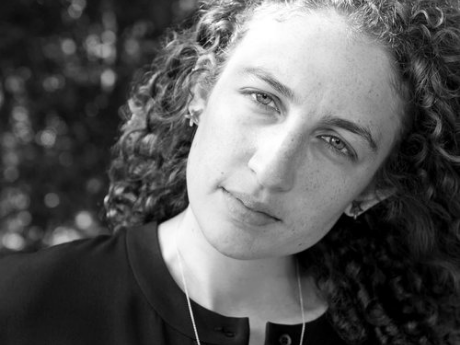In Their Own Words
Adrienne Raphel on “The House on Bayshore”

The House on Bayshore
This is the house on Bayshore.
This is the bulkhead behind the house on Bayshore.
This is the dock that joins the bulkhead behind the house on Bayshore.
This is the Dalmatian that hates the dock that juts from the bulkhead behind the house on Bayshore.
This is the crusted red sore on the foot of the dog that hates the dock that juts from the bulkhead behind the house on Bayshore.
This is the showcase showdown the sore and the Dalmatian who licks the sore and barks at the dock that gives a Bronx cheer to the bulkhead that keeps out the bay from 2425 Bayshore.
This is the sunroom stuffed with the showcase showdown stuff and the minty chew thing the dog ignores to lick the procrustean yellowed sore that throbs at the dock that's rotting behind the bulkhead behind the house on Bayshore.
This is more stuff than ever before the stuff that's behind doors one two three in the showcase showdown seen on TV raw chew things plastic Easter eggs the sore that's gone minty that hobbles the dog so she can't get at the dock that's above the tide that's below the bulkhead that keeps out the bay from the Bayshore.
This is the hurricane that welled up the house and spoiled the stuff in the showcase showdown with the salt that soaked through everything thank god the dog's dead the dock is displayed and the bulkhead's washed up in parallel parking and who will get the wooden white whale hung by the door of the front of the house on Bayshore.
This is the house that went into dumpsters that sat in the driveway behind the full set of the World Book Britannica redbirds in shoeboxes fake Christmas tree without lights attached in a room from the showcase unopened inner tube from QVC the Dalmatian ornaments an electronic globe that fell off the ell in the bay by the bulkhead behind the house that's a lot on Bayshore.
This is the start of a four-story house with foundations on top of the showcase showdown keep the old Easter eggs stars on their shells the dead dotted dog's downward of the dock that never did nothing to nobody see the cockroach comes up from under the lot and jumps over the bulkhead with sudden alacrity runs at the water as fast as the end of the alphabet can at the end of the Bayshore.
From What Was It For (Rescue Press, 2017). All rights reserved. Reprinted with the permission of the author.
On "The House on Bayshore"
In October 2012, my grandfather's house got destroyed in Hurricane Sandy. My grandfather lived in Brigantine, New Jersey, a small island suburb of Atlantic City; he'd been in that house for over fifty years. My mom and her sisters grew up there, and when I was a baby, we lived around the block. I learned to swim off my grandparents' dock. My cousins and I used to hunt Easter eggs in the backyard, the cheap plastic kind with candy or quarters inside; my mom would mark our initials on some of the eggs, so that the bigger cousins wouldn't muscle the little ones out of all the best ones.
After the hurricane, the house wasn't completely gone—that would have been better. The books and clothes were sodden; the furniture, bloated or warped with salt water. All the stuff packed in cardboard boxes had gone mildewed, and day by day, it was decaying into soggy rot. Everything was still there, but most of it was totally unsalvageable.
The form of the poem mimics the weird mix of nostalgia and paranoiac anxiety, this desire to at once hoard and erase everything. This is the house that Jack built, but crumpled; strict repetition warps and crumbles around itself, like the house itself. Elizabeth Bishop's "Visit to St. Elizabeths" is under this—both the house of Bedlam itself and this idea of returning to one's own name and finding in it a madhouse.
Though the poem's stuff comes from one specific house—every item, from the white wooden whale over the door to those cardinal Christmas lights to the inner tubes rotting in QVC boxes, is true—myriad houses haunt the poem. The house is also the house that stands there now, a McMansion comically pushed to fill every square inch of the plot of land; the little house jammed with half a century's worth of life fit much better by the bay than this empty but oversized structure, stuffing the lot to its gills. My great-grandparents' house, also in Brigantine, also on the bay, is secretly infused through the whole process of the book, though it appears nowhere in it. That house was shaped like a ship, with portholes for windows and ropes for railings (it would have made a lousy ark in practice). And the houses are those houses in Hurricane Katrina, roofs turned into rafts; houses swept away in tornadoes; houses skewered in earthquakes; Levittown infinite replicas. The house is a memory palace, but a broken one; we've put the stuff there and we can remember what each thing is meticulously, but what did any of them mean?



